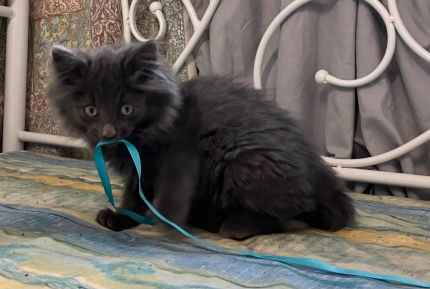Bringing a new kitten or cat into your home is an exciting time filled with anticipation and joy. But amidst all the excitement, it’s crucial to remember that this transition can be a big adjustment for your furry friend. As responsible pet owners, it’s our duty to create a safe, nurturing, and cosy environment that helps your new family member settle in seamlessly. In this all-inclusive guide, we’ll provide you with step-by-step instructions and invaluable tips on how to make your cat feel at home, guaranteeing a harmonious and joyous transition for both you and your precious companion.
Table of Contents
- Preparing for the Arrival
- Introducing Your Cat Into the Home
- Establishing a Routine
- Introducing Family Members and Other Pets
- Building Trust and Bonding
- Setting the Stage for a Bright Future
Preparing for the Arrival
As you eagerly await the arrival of your new feline companion, it’s essential to take the time to prepare your home for their arrival. These preparations are key to ensuring a smooth and comfortable transition for your furry new addition. You can find a new pet with Gumtree too.
Create a safe and comfortable space for your cat/kitten
- Designate a quiet room as their initial sanctuary
- Provide a cosy bed, blankets, and toys
- Set up food and water bowls in a separate area
Gather essential supplies
This may include:
- High-quality cat or kitten food and treats
- Litter box and litter
- A scratching post
- Toys
- Grooming tools and a cat carrier for vet visits
Cat-proof your home
- Secure loose wires and cords
- Remove toxic plants or potential hazards
- Close off access to small spaces or areas of danger
Introducing Your New Cat Into the Home
When bringing a new adult cat or kitten home, it’s crucial to provide them with a gentle and gradual introduction to their new surroundings. This process helps them feel safe, secure, and ultimately eases their transition into the new environment. By taking the time to introduce your feline friend to different areas of your home and familiarising them with their designated spaces, you lay the foundation for a positive and comfortable living experience. Here are some essential steps to follow during the introduction process:
Gradually introduce them to different areas of the home
To prevent overwhelming your new cat or kitten, start by confining them to a small, quiet room for the first few days. This space will serve as their sanctuary and help them adjust to the new scents and sounds of your home. Provide them with all the essentials they need, such as food, water, litter box, and a cosy cat bed. Spend quality time with them in your new cat’s room, allowing them to explore at their own pace and become familiar with their immediate surroundings.
Once your cat shows signs of comfort and confidence in the initial room, gradually expand their territory. Open the door and let them explore additional areas of the house under your supervision. Ensure there are no hidden dangers or potential hazards, and provide hiding spots or safe elevated perches where they can retreat to if they feel overwhelmed.
Familiarise the cat or kitten with their designated spaces
To establish a sense of security and familiarity, show your cat or kitten their litter box, feeding area, and sleeping spot. Place them in these designated spaces so they become acquainted with their locations. Encourage exploration and positive associations by rewarding them with treats or gentle praise when they use the litter box or approach their food bowl.
It’s also helpful to leave an item with their mother’s scent, such as a blanket or toy, in their sleeping area. This familiar scent can provide comfort and reassurance during the adjustment period. Additionally, consider using pheromone sprays or diffusers in the designated areas to create a calming environment, as these products mimic the natural facial pheromones that cats use to mark their territory and feel secure.
Provide hiding spots and cosy areas
Cats are naturally inclined to seek out hiding spots when they feel uncertain or stressed. Providing hiding spots and cosy areas throughout your home gives them a safe retreat where they can relax and observe their surroundings. Install cat trees, shelves, or covered beds in different rooms to create vertical spaces they can climb and explore. Cardboard boxes with holes cut out or blankets draped over furniture can also serve as cosy hideaways.
Allow your cat to discover these hiding spots at their own pace. Avoid forcing them out of their chosen hiding spots or invading their privacy, as this may undermine their trust and prolong the adjustment period. Instead, make these hiding spots appealing by placing treats or toys nearby to encourage positive associations.
Use pheromone products to create a calming atmosphere
Pheromone products, such as sprays or diffusers, can be beneficial in creating a calming atmosphere for your new cat or kitten. These products release synthetic pheromones that mimic the natural ones produced by cats, promoting a sense of wellbeing and security. By utilising pheromone products, you can help reduce anxiety, decrease stress-related behaviours, and facilitate a smoother transition into the new environment.
Place pheromone diffusers strategically around the house, particularly in areas where your cat spends most of their time. These diffusers emit the pheromone continuously, creating a comforting and familiar ambience. Additionally, pheromone sprays can be used on bedding, scratching posts, or carriers to help your cat associate these items with a sense of security.
Remember, each cat is unique, and the adjustment period may vary. Be patient and allow your cat or kitten to settle in at their own pace. By providing a gradual introduction, familiarising them with designated spaces, and creating a calm environment, you set the stage for a successful transition into their new home. In the next section, we will explore the importance of establishing a routine to help your cat feel secure and content in their new environment.
Establishing a Routine
Most cats thrive on routine and predictability. Establishing a consistent daily schedule for your new cat or kitten is crucial in helping them feel secure and settled in their new environment. A routine provides a sense of stability, which can greatly reduce stress and anxiety. Here are some key elements to consider when establishing a routine for your feline companion:
Maintain a consistent feeding schedule
Setting a regular feeding schedule is essential for your cat’s overall wellbeing. Cats are creatures of habit, and they rely on a consistent mealtime routine. Determine the appropriate portion sizes and feeding times based on their age, breed, and dietary needs. Stick to these feeding times and avoid leaving food out all day, as free-feeding can lead to obesity and disrupt the establishment of a routine.
Establish a regular playtime routine
Playtime isn’t only fun for your cat, but it also provides much-needed mental and physical stimulation. Set aside dedicated play sessions each day to engage with your cat. Use interactive toys that mimic prey-like movements, such as feather wands or laser pointers, to engage their natural hunting instincts. Aim for at least 15–20 minutes of playtime, providing an outlet for their energy and promoting a healthy bond between you and your cat.
Set up some safe sleep areas
Cats are known for their love of sleep, often snoozing for long hours throughout the day. Creating a comfortable and designated sleep area for your cat is essential. Choose a quiet and cosy spot away from high-traffic areas and noise. Provide a soft bed or blanket where they can retreat for uninterrupted rest. By establishing a consistent sleep area, you help your cat feel secure and encourage a healthy sleep routine.
Introduce interactive toys and enrichment activities
In addition to playtime, incorporating interactive toys and enrichment activities into your cat’s routine is vital for their mental stimulation and overall wellbeing. Rotate their toys regularly to prevent boredom, and introduce puzzle toys or treat-dispensing toys to engage their problem-solving skills. Consider installing window perches or bird feeders outside to provide visual stimulation, allowing your cat to observe the outside world safely.
Consistency is key when implementing a routine. Stick to the established feeding, playtime, and sleep schedules as closely as possible. Cats quickly learn to anticipate these activities, and a routine can bring a sense of comfort and security to their daily lives.
Introducing Family Members and Other Pets
When bringing a new cat into a home with existing family members and other pets, a gradual and controlled introduction is essential. This process allows everyone to adjust and form positive associations, promoting harmony and minimising potential conflicts. Here are some steps to follow when introducing your new cat to family members and other furry friends:
Start with controlled introductions
Start by allowing your new cat to explore a specific area of the house while keeping other pets separated. This allows them to become familiar with each other’s scents without direct contact. Gradually increase their exposure to each other over several days, using baby gates or a crack in the door to allow visual interaction.
Supervise all interactions
Once your cat and other pets are comfortable with each other’s presence, you can move on to supervised face-to-face introductions. Keep the initial meetings short and positive, ensuring both parties feel safe and relaxed. Reward good behaviour with treats and praise, and be prepared to separate them if any signs of aggression or fear arise.
Take things slow
When introducing cats to other cats, use a slow and controlled approach. Start by swapping bedding or using a scent exchange technique, where you rub a cloth on one cat and introduce it to the other cat, allowing them to become accustomed to each other’s scent. Gradually progress to visual and supervised physical introductions.
Introducing cats to dogs follows a similar process, with a focus on positive associations. Keep dogs on a leash during initial meetings and reward calm and friendly behaviour. Allow the cat to retreat to a safe space if needed, ensuring their comfort and security.
Ensure each pet has their own resources
It’s crucial to provide each pet with its own resources to prevent territorial disputes. This includes separate food and water bowls, litter boxes, and comfortable resting areas. Giving each pet their designated spaces and resources promotes a sense of ownership and reduces the likelihood of conflict.
Patience and monitoring are essential throughout the introduction process. Remember that each pet has a unique personality and may require different lengths of time to adjust. If any significant issues or signs of aggression arise, seek guidance from a professional animal behaviourist or your veterinarian to ensure a smooth and successful integration.
By gradually introducing family members and other pets, you foster positive relationships and promote a harmonious living environment. A gradual and patient approach allows everyone to adapt at their own pace, increasing the chances of forming strong bonds and creating a loving and cohesive family unit.
Building Trust and Bonding
Building a strong bond with your new cat isn’t just important for their emotional wellbeing but also for creating a harmonious and fulfilling relationship between you and your furry friend. Here are some tips to help you establish trust and foster a deep connection during the settling-in process:
- Give them space and allow them to approach you. Understand that cats are naturally cautious and independent creatures. Respect their need for personal space and avoid overwhelming them with constant attention. Give them the freedom to explore their surroundings and approach you on their own terms. This approach will help them feel more secure and gradually build trust in their new home.
- Use positive reinforcement techniques. Encourage positive behaviours by using rewards such as treats, praise, and gentle petting. Whenever your cat exhibits good behaviour, such as using the litter box or using their scratching post, reward them with a treat and offer words of praise. This positive reinforcement will allow them to associate their actions with positive outcomes, strengthening the bond between you two.
- Spend quality time together. Dedicate time each day to engage in activities that your cat enjoys. This can include gentle play sessions with their favourite toys, interactive games, or even grooming sessions. Not only will these activities provide mental and physical stimulation for your cat, but they will also create moments of connection and build trust. Pay attention to your cat’s preferences and cater to their individual needs accordingly.
- Respect their boundaries. Pay attention to your cat’s body language and cues. If they show signs of discomfort or resistance, such as flattened ears or a swishing tail, it’s important to respect their boundaries and give them space. Forcing interactions or disregarding their signals can erode trust and hinder the bonding process. Allow your cat to set the pace and gradually increase the level of interaction as they become more comfortable.
- Be patient and consistent. Building trust and forming a strong bond takes time and patience. Every cat is unique, and some may take longer than others to fully adjust and open up. Remain consistent in your approach, providing a safe and nurturing environment while being mindful of your cat’s individual needs and preferences. With time, your efforts will be rewarded as your bond with your cat grows stronger.
Remember, building trust and bonding with your new cat is a journey that requires understanding, patience, and love. By allowing them space, using positive reinforcement, spending quality time together, and respecting their boundaries, you create a foundation for a deep and loving relationship that will last a lifetime.
Setting the Stage for a Bright Future
Bringing a new cat or kitten into your home is a joyous occasion, but it requires careful planning, patience, and a whole lot of love. By following the steps outlined in this guide, you can create a safe and welcoming environment that helps your new furry friend settle into their new home with ease. For more tips on how to take care of your pet, check out our pet advice section too. Remember to be patient, understanding, and to prioritise their physical and emotional wellbeing. With time and care, your resident cat will thrive in their new surroundings, becoming a cherished member of your family for years to come.
Petinsurance.com.au is issued by The Hollard Insurance Company Pty Ltd ABN 78 090 584 473, AFSL 241436, is arranged and administered by PetSure (Australia) Pty Ltd ABN 95 075 949 923, AFSL 420183 (PetSure) and is promoted and distributed by PetSure’s Authorised Representatives (AR) Pet Insurance Pty Ltd ABN 38 607 160 930, AR 1234944 and Gumtree AU Pty Ltd ABN 33 616 996 840, AR 1304608. Any advice provided is general only and does not take into account your individual objectives, financial situation or needs. Please consider the Product Disclosure Statement (PDS) to ensure this product meets your needs before purchasing. PDS and Target Market Determination available at petinsurance.com.au.
























